Archaeologists have discovered a rare stone delineating the city limits of ancient Rome that dates from the age of Emperor Claudius in 49 A.D. and was found during excavations for a new sewage system.
Rome Mayor Virginia Raggi was on hand for the unveiling Friday of the pomerial stone, a huge slab of travertine that was used as a sacred, military and political perimeter marking the edge of the city proper with Rome’s outer territory.
It was found June 17 during excavations for a rerouted sewer under the recently restored mausoleum of Emperor Augustus, right off the central Via del Corso in Rome’s historic center.
In ancient Rome, the area of the pomerium was a consecrated piece of land along the city walls, where it was forbidden to farm, live or build and through which it was forbidden to enter with weapons.
At a press conference in the Ara Pacis museum near the mausoleum, Claudio Parisi Presicce, director of the Archaeological Museums of Rome, said the stone had both civic and symbolic meaning.
Find your dream job in the space industry. Check our Space Job Board »
“The founding act of the city of Rome starts from the realization of this ‘pomerium,”’ he said of the consecrated area. The stone features an inscription that allowed archaeologists to date it to Claudius and the expansion of the pomerium in 49 A.D., which established Rome’s new city limits.
A detail of an archeological finding emerged during the excavations at a Mausoleum is pictured during its presentation to the press in Rome, Friday, July 16, 2021. The monumental pomerial stone is dating back to Roman Emperor Claudio and was used to mark the ‘pomerium’ the sacred boundaries of the ‘Urbe’, the city of Rome, during the Roman empire. Credit: AP Photo/Domenico Stinellis
Photographers take pictures during the presentation to the press of an archeological finding emerged during the excavations at a Mausoleum in Rome, Friday, July 16, 2021. The monumental pomerial stone is dating back to Roman Emperor Claudio and was used to mark the ‘pomerium’ the sacred boundaries of the ‘Urbe’, the city of Rome, during the Roman empire. Credit: AP Photo/Domenico Stinellis
Rome’s Mayor Virginia Raggi, answers to journalists’ questions, during the presentation to the press of an archeological finding emerged during the excavations at a Mausoleum in Rome, Friday, July 16, 2021. The monumental pomerial stone is dating back to Roman Emperor Claudio and was used to mark the ‘pomerium’ the sacred boundaries of the ‘Urbe’, the city of Rome, during the Roman empire. Credit: AP Photo/Domenico Stinellis
Rome’s Mayor Virginia Raggi, center, backdropped by the Ara Pacis (Altar of Peace) presents to journalists an archeological finding emerged during the excavations at a Mausoleum in Rome, Friday, July 16, 2021. The monumental pomerial stone is dating back to Roman Emperor Claudio and was used to mark the ‘pomerium’ the sacred boundaries of the ‘Urbe’, the city of Rome, during the Roman empire. Credit: AP Photo/Domenico Stinellis
A photographer takes pictures during the presentation to the press of an archeological finding emerged during the excavations at a Mausoleum in Rome, Friday, July 16, 2021. The monumental pomerial stone is dating back to Roman Emperor Claudio and was used to mark the ‘pomerium’ the sacred boundaries of the ‘Urbe’, the city of Rome, during the Roman empire. Credit: AP Photo/Domenico Stinellis
Photographers take pictures during the presentation to the press of an archeological finding emerged during the excavations at a Mausoleum in Rome, Friday, July 16, 2021. The monumental pomerial stone is dating back to Roman Emperor Claudio and was used to mark the ‘pomerium’ the sacred boundaries of the ‘Urbe’, the city of Rome, during the Roman empire. Credit: AP Photo/Domenico Stinellis
A detail of an archeological finding emerged during the excavations at a Mausoleum is pictured during its presentation to the press in Rome, Friday, July 16, 2021. The monumental pomerial stone is dating back to Roman Emperor Claudio and was used to mark the ‘pomerium’ the sacred boundaries of the ‘Urbe’, the city of Rome, during the Roman empire. Credit: AP Photo/Domenico Stinellis
Photographers take pictures during the presentation to the press of an archeological finding emerged during the excavations at a Mausoleum in Rome, Friday, July 16, 2021. The monumental pomerial stone is dating back to Roman Emperor Claudio and was used to mark the ‘pomerium’ the sacred boundaries of the ‘Urbe’, the city of Rome, during the Roman empire. Credit: AP Photo/Domenico Stinellis
- Raggi noted that only 10 other stones of this kind had been discovered in Rome, the last one 100 years ago.
“Rome never ceases to amaze and always shows off its new treasures,” she said.
The stone will be on display at the Ara Pacis museum, the Richard Meier-designed home of a 1st century altar until the Augustus museum opens.



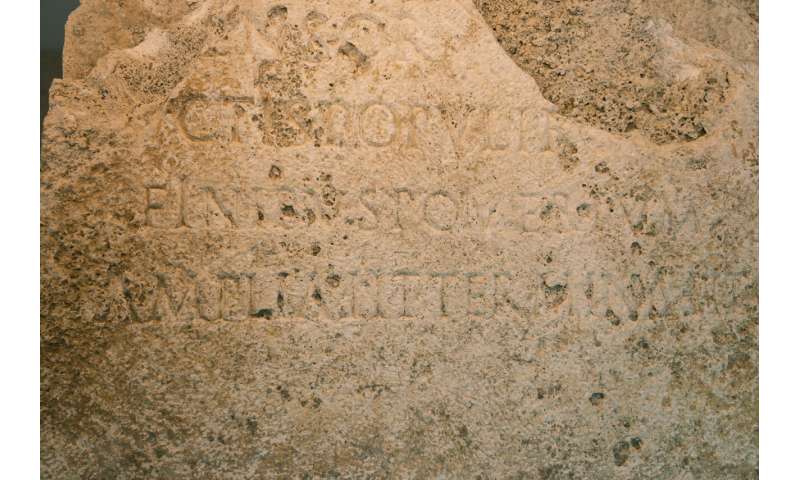 A detail of an archeological finding emerged during the excavations at a Mausoleum is pictured during its presentation to the press in Rome, Friday, July 16, 2021. The monumental pomerial stone is dating back to Roman Emperor Claudio and was used to mark the ‘pomerium’ the sacred boundaries of the ‘Urbe’, the city of Rome, during the Roman empire. Credit: AP Photo/Domenico Stinellis
A detail of an archeological finding emerged during the excavations at a Mausoleum is pictured during its presentation to the press in Rome, Friday, July 16, 2021. The monumental pomerial stone is dating back to Roman Emperor Claudio and was used to mark the ‘pomerium’ the sacred boundaries of the ‘Urbe’, the city of Rome, during the Roman empire. Credit: AP Photo/Domenico Stinellis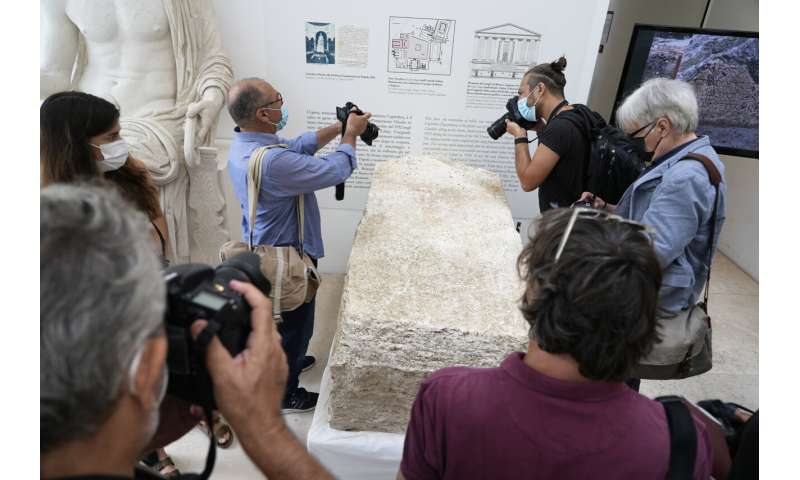 Photographers take pictures during the presentation to the press of an archeological finding emerged during the excavations at a Mausoleum in Rome, Friday, July 16, 2021. The monumental pomerial stone is dating back to Roman Emperor Claudio and was used to mark the ‘pomerium’ the sacred boundaries of the ‘Urbe’, the city of Rome, during the Roman empire. Credit: AP Photo/Domenico Stinellis
Photographers take pictures during the presentation to the press of an archeological finding emerged during the excavations at a Mausoleum in Rome, Friday, July 16, 2021. The monumental pomerial stone is dating back to Roman Emperor Claudio and was used to mark the ‘pomerium’ the sacred boundaries of the ‘Urbe’, the city of Rome, during the Roman empire. Credit: AP Photo/Domenico Stinellis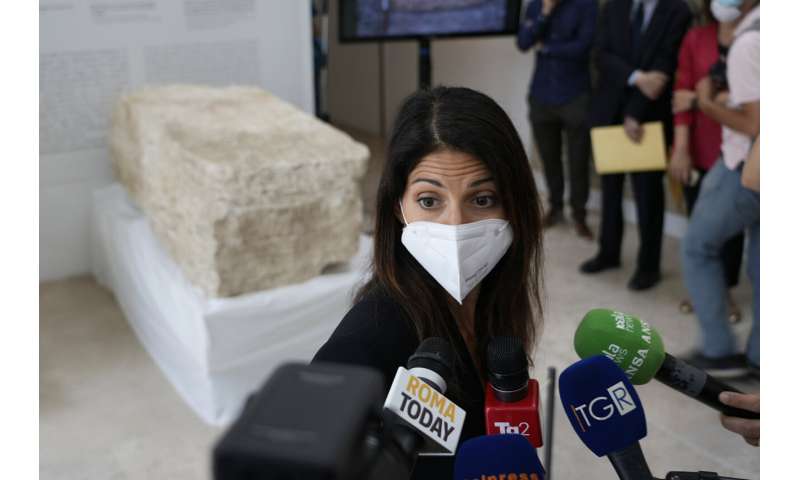 Rome’s Mayor Virginia Raggi, answers to journalists’ questions, during the presentation to the press of an archeological finding emerged during the excavations at a Mausoleum in Rome, Friday, July 16, 2021. The monumental pomerial stone is dating back to Roman Emperor Claudio and was used to mark the ‘pomerium’ the sacred boundaries of the ‘Urbe’, the city of Rome, during the Roman empire. Credit: AP Photo/Domenico Stinellis
Rome’s Mayor Virginia Raggi, answers to journalists’ questions, during the presentation to the press of an archeological finding emerged during the excavations at a Mausoleum in Rome, Friday, July 16, 2021. The monumental pomerial stone is dating back to Roman Emperor Claudio and was used to mark the ‘pomerium’ the sacred boundaries of the ‘Urbe’, the city of Rome, during the Roman empire. Credit: AP Photo/Domenico Stinellis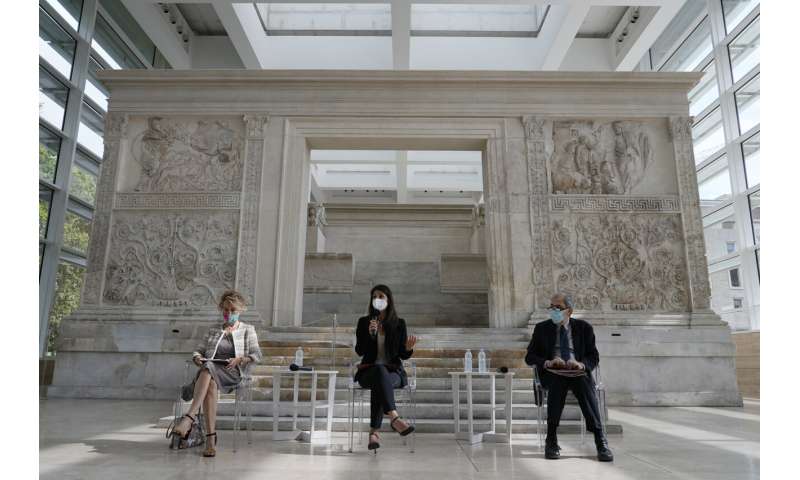 Rome’s Mayor Virginia Raggi, center, backdropped by the Ara Pacis (Altar of Peace) presents to journalists an archeological finding emerged during the excavations at a Mausoleum in Rome, Friday, July 16, 2021. The monumental pomerial stone is dating back to Roman Emperor Claudio and was used to mark the ‘pomerium’ the sacred boundaries of the ‘Urbe’, the city of Rome, during the Roman empire. Credit: AP Photo/Domenico Stinellis
Rome’s Mayor Virginia Raggi, center, backdropped by the Ara Pacis (Altar of Peace) presents to journalists an archeological finding emerged during the excavations at a Mausoleum in Rome, Friday, July 16, 2021. The monumental pomerial stone is dating back to Roman Emperor Claudio and was used to mark the ‘pomerium’ the sacred boundaries of the ‘Urbe’, the city of Rome, during the Roman empire. Credit: AP Photo/Domenico Stinellis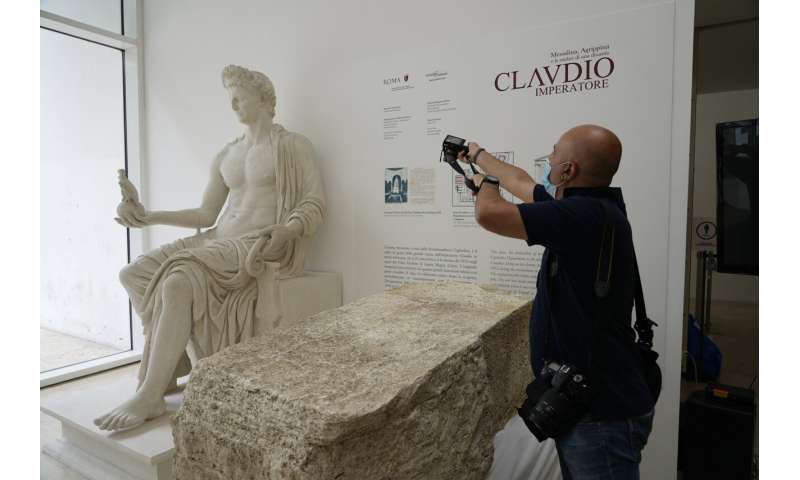 A photographer takes pictures during the presentation to the press of an archeological finding emerged during the excavations at a Mausoleum in Rome, Friday, July 16, 2021. The monumental pomerial stone is dating back to Roman Emperor Claudio and was used to mark the ‘pomerium’ the sacred boundaries of the ‘Urbe’, the city of Rome, during the Roman empire. Credit: AP Photo/Domenico Stinellis
A photographer takes pictures during the presentation to the press of an archeological finding emerged during the excavations at a Mausoleum in Rome, Friday, July 16, 2021. The monumental pomerial stone is dating back to Roman Emperor Claudio and was used to mark the ‘pomerium’ the sacred boundaries of the ‘Urbe’, the city of Rome, during the Roman empire. Credit: AP Photo/Domenico Stinellis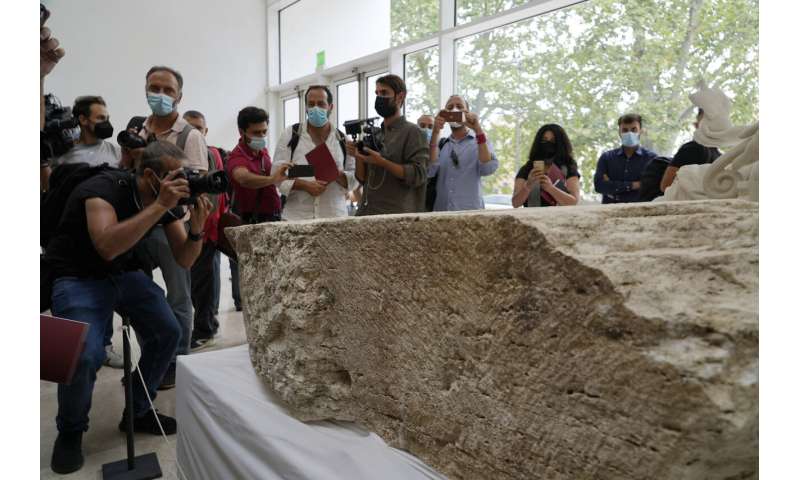 Photographers take pictures during the presentation to the press of an archeological finding emerged during the excavations at a Mausoleum in Rome, Friday, July 16, 2021. The monumental pomerial stone is dating back to Roman Emperor Claudio and was used to mark the ‘pomerium’ the sacred boundaries of the ‘Urbe’, the city of Rome, during the Roman empire. Credit: AP Photo/Domenico Stinellis
Photographers take pictures during the presentation to the press of an archeological finding emerged during the excavations at a Mausoleum in Rome, Friday, July 16, 2021. The monumental pomerial stone is dating back to Roman Emperor Claudio and was used to mark the ‘pomerium’ the sacred boundaries of the ‘Urbe’, the city of Rome, during the Roman empire. Credit: AP Photo/Domenico Stinellis







